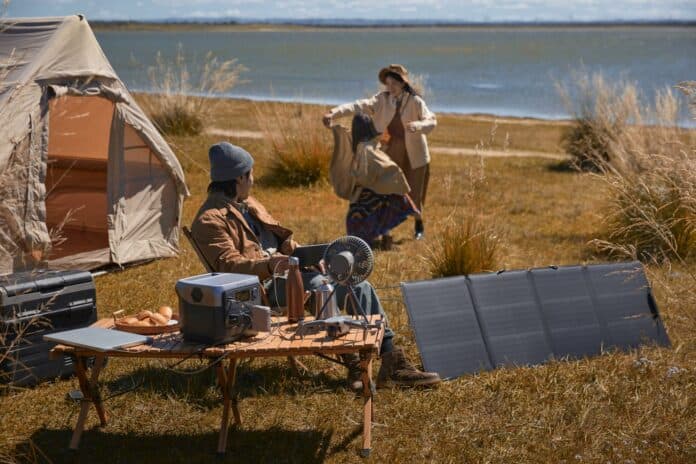Coffee is an essential part of the morning routine for millions, if not billions, of people worldwide. You need that energising caffeine boost to shake off those remnants of sleep and start the day on the right foot.
Getting your morning cup of java is a relatively straightforward process in a traditional home. However, in camping, motorhomes, campervans, or off-grid homes, those small processes have a habit of becoming much more complex. Even the occasional power outage can spell disaster and prevent you from getting that much-needed morning boost.
Coffee makers only operate for a short period but consume a relatively large amount of power while your coffee brews. Using a solar generator to make your morning cup is possible, but there are a few things to remember.
Can a Solar Generator Power a Coffee Maker?
Many solar generators have enough power to operate a coffee maker efficiently. A solar generator like the DELTA 2 + 220W panel has a storage capacity of 1kWh with a power output capacity of up to 1800W. That’s more than enough power to run most standard coffee makers!
That said, it’s important to note that coffee makers come in all shapes and sizes, which means a wide range of power consumption requirements. A solar generator that can run a single-serve drip coffee maker might not be capable of running a commercial-sized espresso machine.
There are many ways to use a solar generator to power a coffee maker, from keeping it on your counter at home as a backup energy supply and keeping it charged with AC electricity, to bringing it with you on camping trips and setting up the portable solar panel when you need power on the go.
However, you may run into issues with the most portable and cheaper solar generators, especially with the maximum AC output. Keep in mind that appliances often need more surge power to start up than they need to run. You’ll have to monitor your energy consumption and your run times closely.
Also, using solar energy to power a coffee maker requires solar panels. Portable power stations don’t come with solar panels as standard, but solar generators do. Solar energy is clean, renewable, and abundant but requires more time to recharge the generator than when plugged into a household (AC) wall outlet.
How Much Power Does a Coffee Maker Use?
Coffee makers often consume a surprisingly large amount of power. A small drip coffee maker (4-5 cups) will use between 500 and 900 watts, while something larger will usually require output somewhere between 750 and 1200 watts.
Coffee makers that use capsules, such as Nespresso or Keurig, consume 900 to 1500 watts, while automatic espresso machines use between 1000 and 1500 watts.
Those numbers are surprisingly large, but they’re also slightly misleading. Appliance wattage, measured in watt-hours, indicates the energy consumed in one hour. Not all appliances — including coffee makers — need to run for such an extended period.
For example, a 50-inch plasma TV will consume 150 to 200 watts per hour, meaning it has a lower overall wattage rating than almost any coffee maker. However, unless you are catering to hundreds of people, you’re almost certainly not going to run a coffee maker at peak capacity for an hour.
Also, keep in mind that coffee makers operate differently. An espresso machine requires a short sharp burst of electricity but also has a very short run time. On the other hand, drip coffee machines use a surge of electricity to produce the coffee but maybe only around 60W an hour to keep it warm.
Understanding the Power Requirements of Coffee Makers
Understanding your coffee maker’s power requirements will let you estimate what size solar generator you need.
Suppose your small drip coffee machine takes five minutes to brew a pot. Working at 750 watts per hour, it will only use 62.5 watts of energy (750Wh / 12 = 62.5). Now, say you wanted to keep that coffee warm for an hour and a half, and the continuous power to maintain the temperature required 60W. You would use an additional 90 watts for a total wattage cost of 152.5 watts.
The 750W is the coffee maker’s rated capacity, or the most energy it will use. It means you’ll need a solar generator with an overall capacity exceeding 152.5W and an output capacity of over 750W.
Solar generators vary enormously in storage capacity and maximum power output. The smallest may have an output capacity of 500W, while the largest can output many thousands of watts.
The essential point to consider is the maximum AC output of the solar generator. The output capacity refers to the maximum energy the generator can supply at once.
A small, portable generator, such as the River 2 Solar Generator, has a 256Wh capacity but a surge output capacity of 600W. That’s enough to power a machine that makes two cups of coffee – perfect for your next camping trip!
If you’re using a larger solar generator, like the DELTA Pro solar generator, which has an output of 3600W rated capacity with a surge output of 4500W with X-Boost, you won’t have to worry about brewing coffee. A coffee machine will hardly put a dent in its storage and output.
How to Connect Your Coffee Maker to a Solar Generator
You can connect coffee makers to a solar generator like any other appliance — simply plug the AC plug from the coffee machine into one of the AC outlets, and you’re ready to go.
Solar generators include multiple output options, including AC, DC, USB-C, and USB-A. Coffee makers will typically use the AC outlet on the generator, although you may find portable electric coffee makers that use USB or 12/24V DC charging. The best option is to check the specs of your solar generator and coffee machine to ensure compatibility.
Once you’ve exhausted the generator’s capacity, it’s a case of setting up the solar panels and waiting for it to recharge. Solar charging can take anywhere from one hour for the smallest generators to over six hours for the largest portable power stations.
How long a solar generator takes to fully recharge using strictly solar charging depends on the number and rated power capacity of the solar panels and environmental factors like available sunlight.
If you’re using the solar generator at home and have it on your kitchen counter, you may also need to consider solar panel placement. You’ll need to set up the portable solar panels to recharge the battery when it runs low, somewhere with direct sun or outside.
Of course, you always have the option to keep it charged with AC electricity — as long as you’re not making coffee in a power outage.
How Long Can You Power a Coffee Maker Using a Portable Solar Generator?
Most portable solar generators can power some coffee makers, but it depends on the generator’s output capacity and the power requirements of the coffee maker. Smaller portable generators may struggle with the maximum AC output required to start and run a coffee maker.
When it comes to how long a generator could power a coffee machine, the answer could be a couple of hours for the smallest to all day for the largest. It depends on how much electricity your coffee machine consumes — and how many cups of coffee you make.
Using a Solar Generator to Power Other Appliances
Depending on the power output capacity of the solar generator, it can provide electricity for your whole home — even during an extended blackout.
The best way to determine what size generator you need is to add up the power requirements of the essential appliances you want to operate.
Here’s how.
Determining Your Wattage Requirements
Before using a generator, you will want to determine how much power you need.
- Identify the wattage requirements of your appliances. Survey the starting and running wattage requirements of the appliances and devices you plan to plug into the generator. You can usually find the wattage requirements labelled on the appliance, but we’ve also compiled the starting and running watts of typical household appliances in the table below.
- Convert volts/amps to watts. If your appliance’s power requirements are in volts or amps, you can calculate an appliance’s running watts with this equation:
Volts (V) x Amps (A) = Watts (W)
- Count the running watts of your appliances. Add up the running watts of the appliances you plan to use — does the total exceed the running watts listed on your generator? If so, you should consider buying a generator with more output capacity.
- Factor in starting watt requirements. Identify the appliance with the highest starting wattage. Add that appliance’s starting wattage to the running wattage total.
- Calculate the sum. That final number is the total starting watts you need from your generator. As discussed above, to avoid overloading your generator, do not exceed its starting watts rating.
Starting and Running Watts of Typical Household Appliances
| Appliance | Rated (Running) Watts | Starting Watts |
| Dishwasher | 1300 | 1800 |
| Washing Machine | 1200 | 2300 |
| Refrigerator/Freezer | 700 | 2200 |
| Light Bulb | 60-75 | 0 |
| Microwave | 600-1000 | 0 |
| TV | 500 | 0 |
| Toaster | 900 | 0 |
| Vacuum | 1440 | 2500 |
| Coffee Maker | 1000 | 0 |
| Blender | 300 | 800 |
| Clothing Iron | 1500 | 0 |
| Dryer | 5400 | 7000 |
| Toaster Oven | 1200 | 0 |
| Curling Iron | 1500 | 0 |
| Space Heater | 2000 | 0 |
| Laptop | 50-300 | 0 |
| 20” Box Fan | 200 | 350 |
Additional Tips and Recommendations
When combining a coffee maker with a solar generator, ensure the generator has a higher wattage than your coffee machine with a sufficient maximum AC output to get it started. Without these two, your fancy espresso machine won’t even turn on — let alone make your morning mochaccino.
Conclusion
Most solar generators can run consumer coffee makers without any issues. However, to avoid missing out on your morning cup of coffee, it’s worth doing the research into your solar generator’s rated capacity and maximum AC output to ensure it can live up to your coffee maker’s power requirements.
Solar generators are the best way for consumers to access clean and renewable energy. For a reliable solar generator that you can take camping or on the road, consider the RIVER 2 portable solar generators from EcoFlow. They’re the perfect backup power source to ensure you can have your coffee anywhere, even on top of a mountain.


